Woodhall Junction, Woodhall Spa and Horncastle
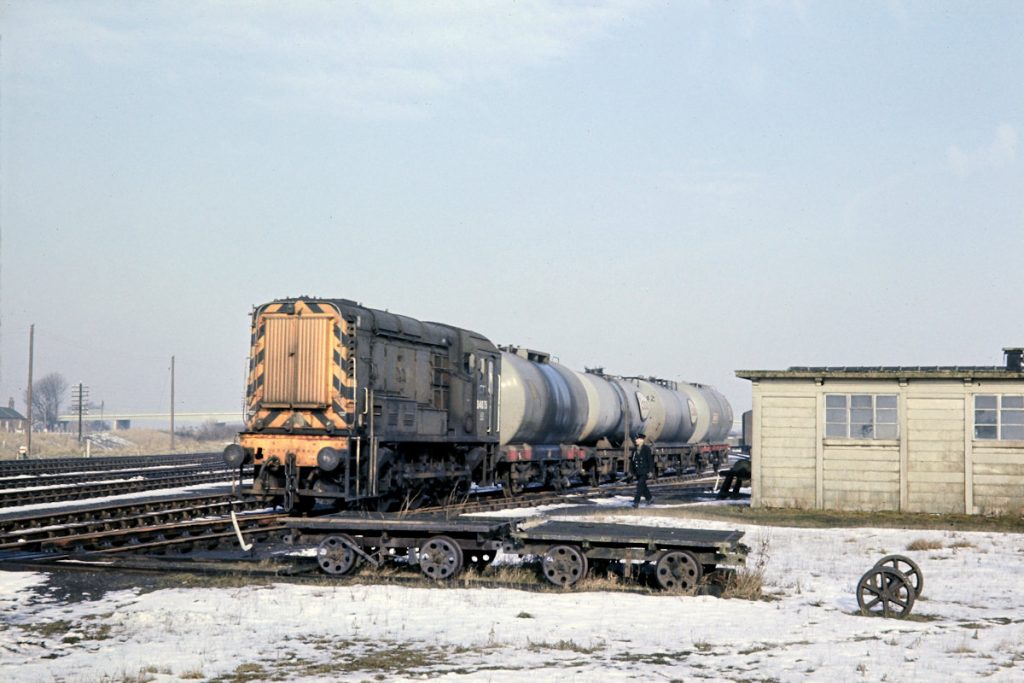
Woodhall Junction was the point at which the 'New Line' to Bellwater Junction left the 'Loop Line' (the physical junction was South of Woodhall Junction at Coningsby Junction). It was also the junction for the Horncastle Branch which lay to the East of the station and faced East, requiring trains from the station to propel out and reverse. On a cold February 19th 1970, after a light fall of snow, Blackstone-engined Class 10 No. D4075 marshals its four fuel tanks for the Horncastle Esso depot before attaching the brake van, running round, propelling out to the junction and heading up the Branch with 9K77, the 10.19 (SX) Lincoln Holmes Yard to Horncastle. Photo: John Tolson, courtesy Trevor Davis.
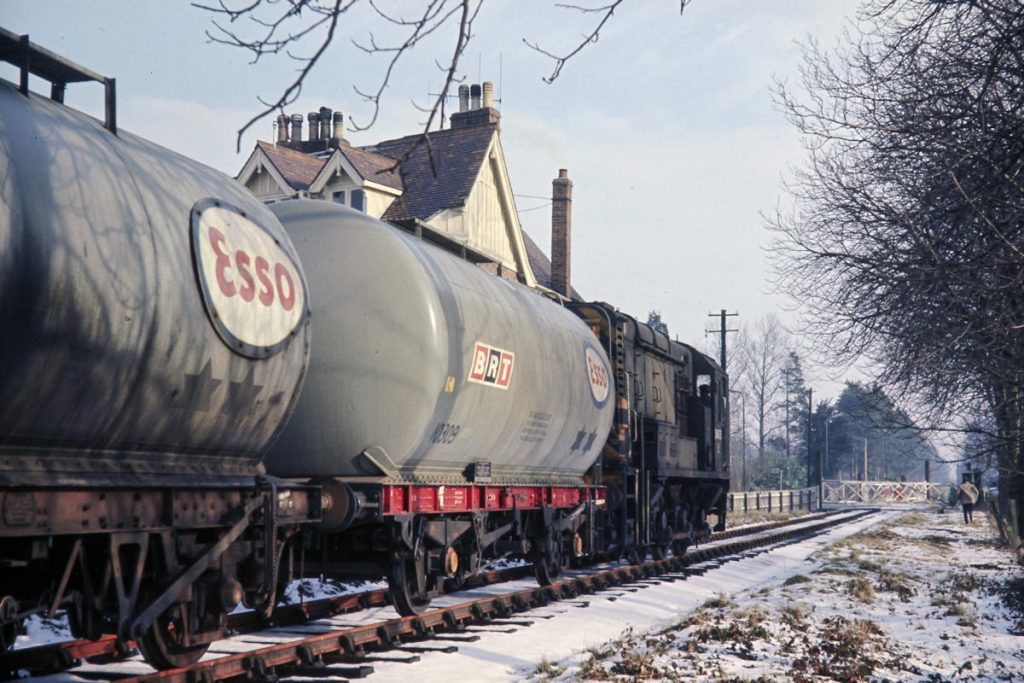
On February 19th 1970, BR Class 10 No. D4075 slows for the level crossing with Station Road/The Broadway just before the former station in Woodhall Spa with 9K77, the 10.19 (SX) Lincoln Holmes Yard to Horncastle, comprising four Esso tanks. Woodhall Spa is most famously known for its Second World War RAF base which was home to 617 Squadron and the Lancasters that carried out the Dam Busters raid. Photo: John Tolson, courtesy Trevor Davis.
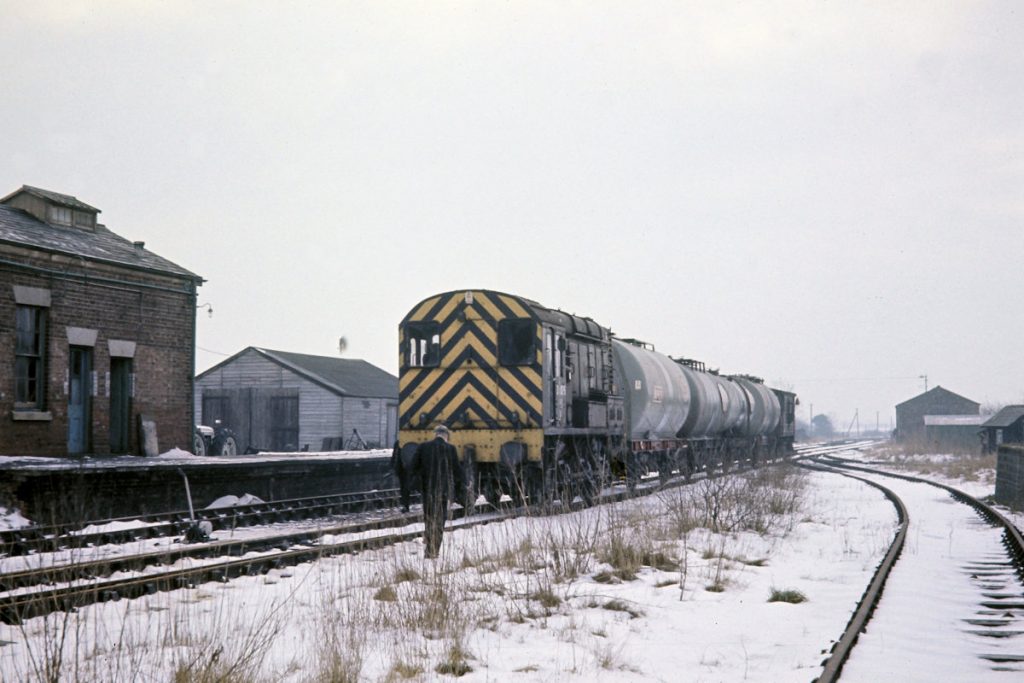
On Thursday 19th February 1970, Lincoln-based BR Class 10 No. D4075 has just arrived at Horncastle at 13.05 with four oil tanks on 9K77, 10.19 from Lincoln Holmes Yard, for the depot behind the station building. After arrival, D4075 uncoupled, collected a single empty oil tank from the depot, put this on to the back of the brake van, shunted the four loaded tanks, brake van and single empty into the oil depot, then uncoupled the brake van from the loaded tanks and returned to the station to wait departure at 14.03 with 9K79 to Holmes Yard. Photo: John Tolson, courtesy Trevor Davis.

After uncoupling from 9K77, the 10.19 from Lincoln Holmes Yard on February 19th 1970, BR Class 10 No. D4075 has run into the headshunt at Horncastle station and is running back to collect a single empty oil tank from the depot behind the station. The Class 10 was similar to the Class 08 but had a Blackstone engine and GEC traction motors compared to the Class 08's English Electric engine and traction motors. D4075 was built at Darlington in 1961 and was one of the last of the Class 10s to be withdrawn, in June 1972. Photo: John Tolson, courtesy Trevor Davis.
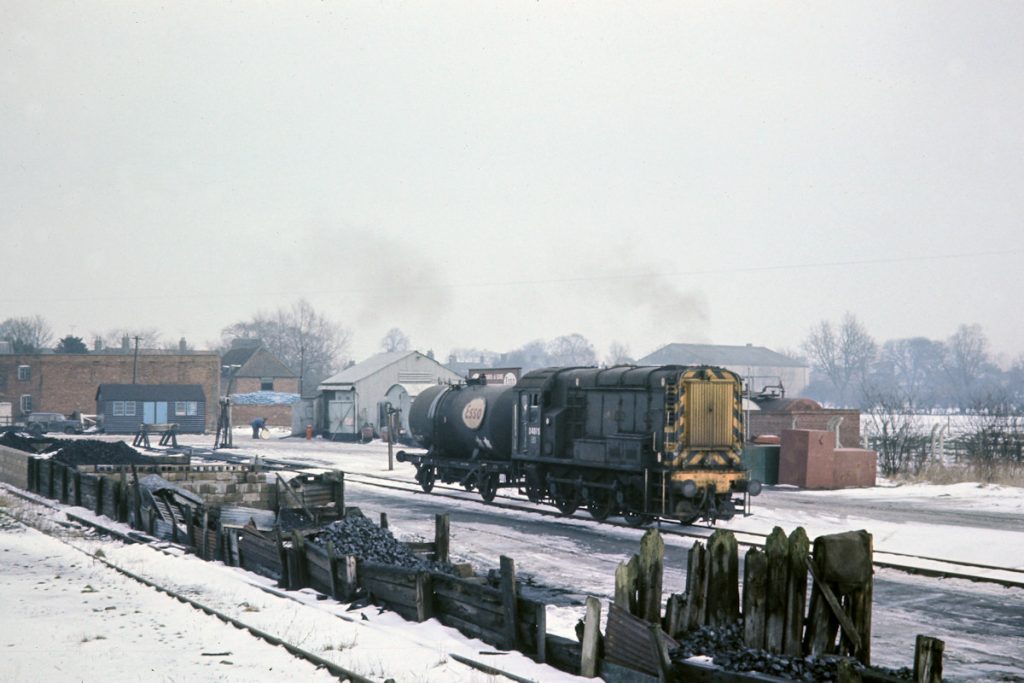
BR Class 10 No. D4075 draws a single empty oil tank out of the Esso depot at Horncastle on February 19th 1970. It will attach this wagon to the rear of the inward train of four full tanks then drop off the four loaded tanks in this siding. The oil and coal depot would have been an essential part of life in this rural part of Lincolnshire, supplying fuels to many of the farms and villages. Photo: John Tolson, courtesy Trevor Davis.
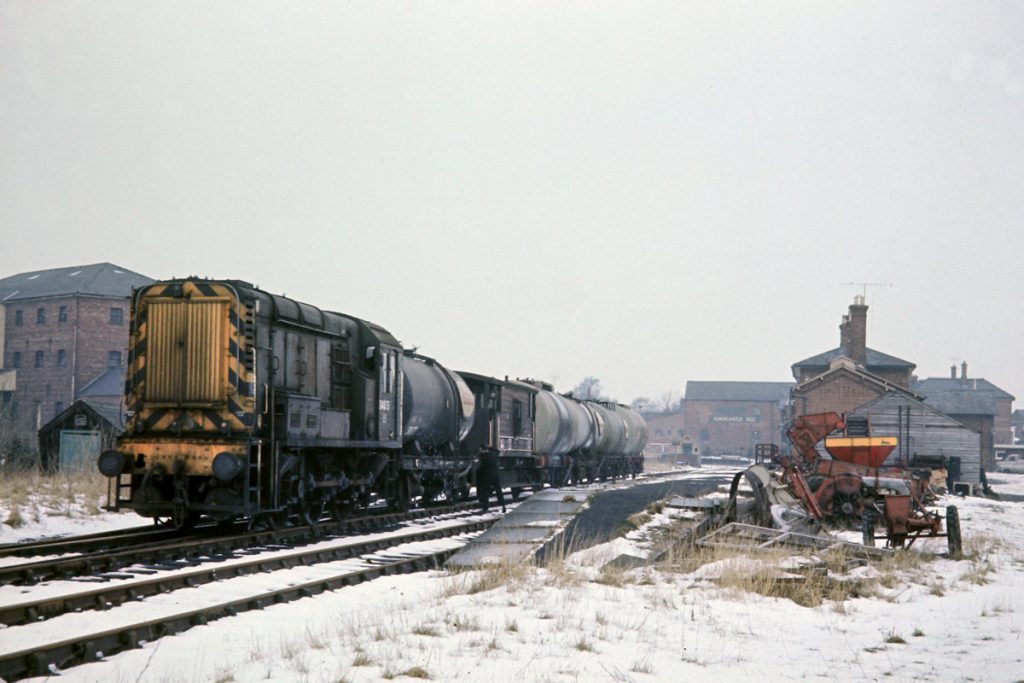
Having picked up a single empty tanker from the Esso siding at Horncastle on February 19th 1970, the guard is hooking it up to the LMS-style brake van of 9K77 from Holmes Yard. After this, BR Class 10 No. D4075 will shunt the formation into the oil siding (off the picture on the right) and will drop off the four loaded tanks. It will then draw out of the siding and reverse up to the far end of the station to wait time before its departure as 9K79, the 14.03 to Holmes Yard. At Greetwell Junction it will not take the Lincoln Avoiding Line but instead travel over Pelham Street Crossing and through Lincoln Central to reach Holmes Yard at 17.17. Photo: John Tolson, courtesy Trevor Davis.
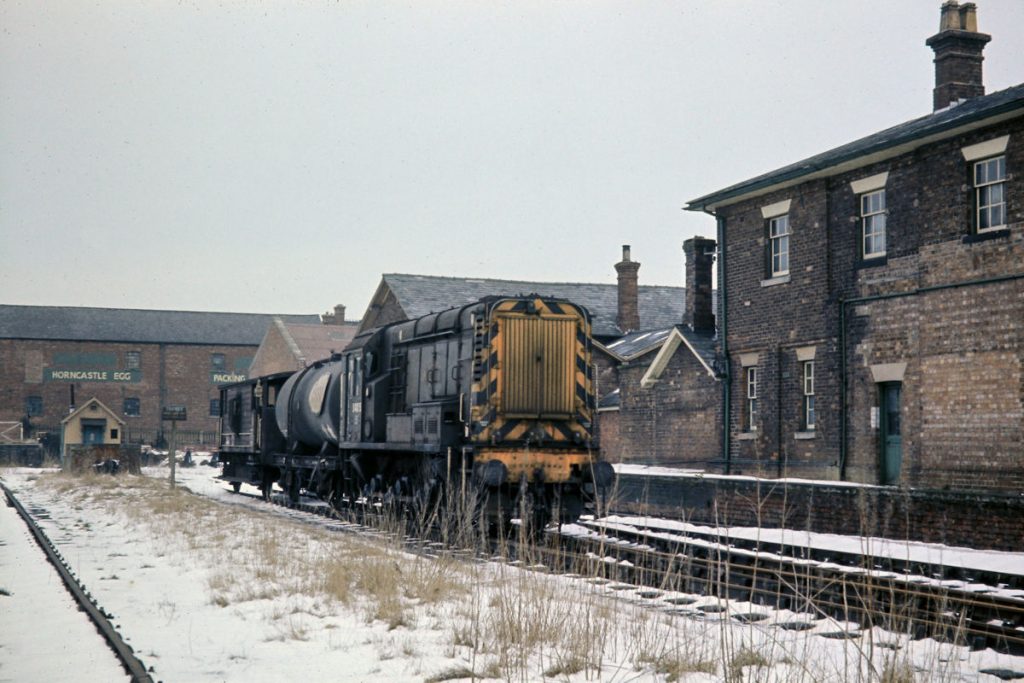
Having completed its shunting movements at Horncastle on February 19th 1970, Blackstone-engined BR Class 10 No. D4075 waits time before departing for Woodhall Junction and Lincoln Holmes Yard as 9K79 at 14.03. Passenger services to Horncastle were withdrawn on 13th September 1954 and good facilities closed on 5th April 1971, shortly after closure of the majority of the East Lincolnshire network as of Monday 5th October 1970. Photo: John Tolson, courtesy Trevor Davis.
Timetables for 9K77 / 9K79
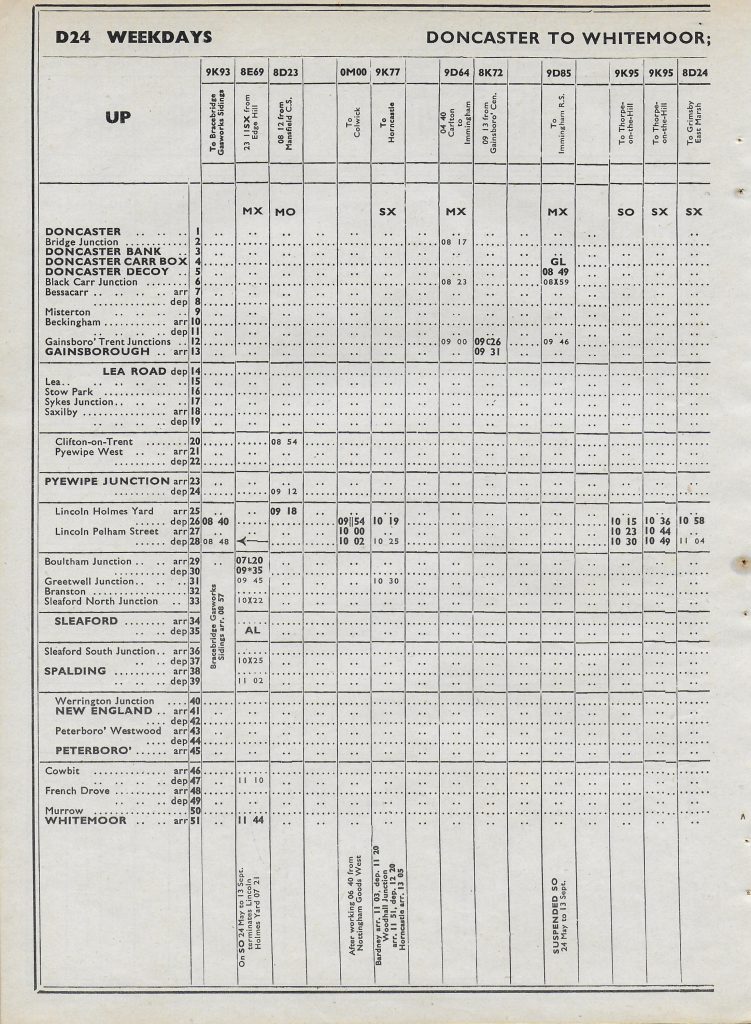
May 1969 BR Eastern Region Working Time Table Section D (Lincoln Area) page D24 showing 9K77, 10.19 (SX) Lincoln Holmes Yard to Horncastle, calling at Bardney from 11.03 to 11.20 and Woodhall Junction from 11.51 to 12.20, arriving in Horncastle at 13.05. The return working, 9K79, departed Horncastle at 14.03 giving just under an hour to shunt the oil siding and take a break. Photo: Alan Jones.
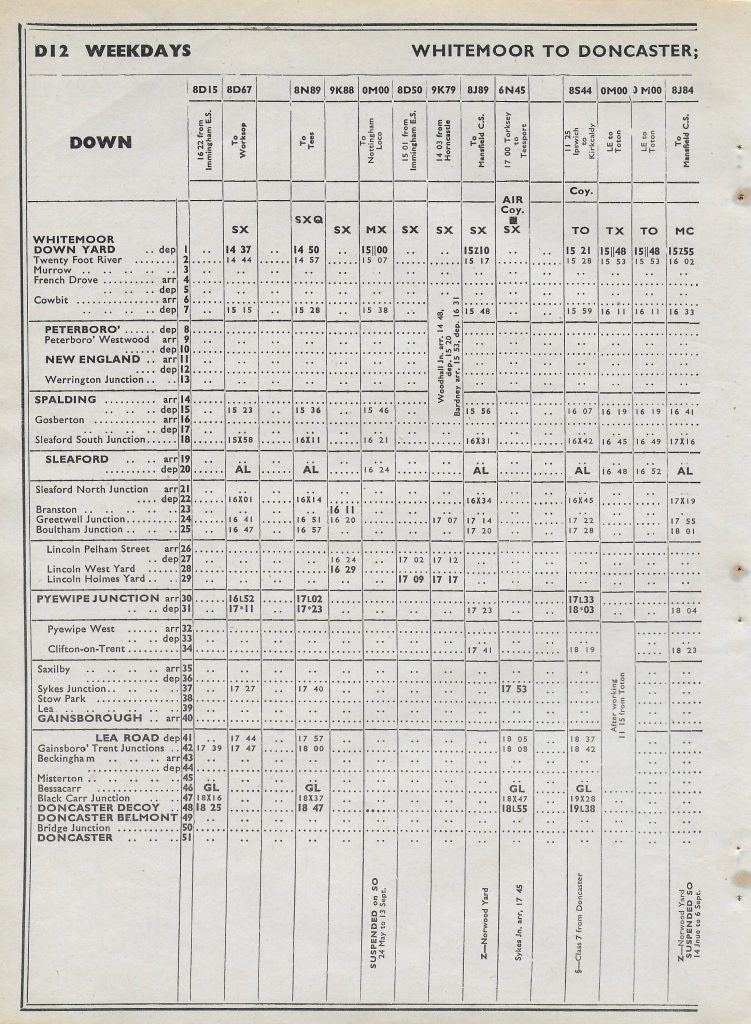
May 1969 BR Eastern Region Working Time Table Section D (Lincoln Area) page D12 showing 9K79, 14.03 (SX) Horncastle to Lincoln Holmes Yard which arrived at Woodhall Junction at 14.48. It departed at 15.20, calling at Bardney from 15.53 to 16.31 where it passed both the 16.00 Lincoln Central to Tumby Woodside and the 15.22 Firsby to Lincoln Central which crossed in the station. After joining the Joint Line at Greetwell Junction at 17.07, 9K79 did not travel via the Lincoln Avoiding Line to reach Holmes Yard, but went over Pelham Street Crossing and through Central Station to arrive at Holmes Yard at 17.17. Photo: Alan Jones.
Maps
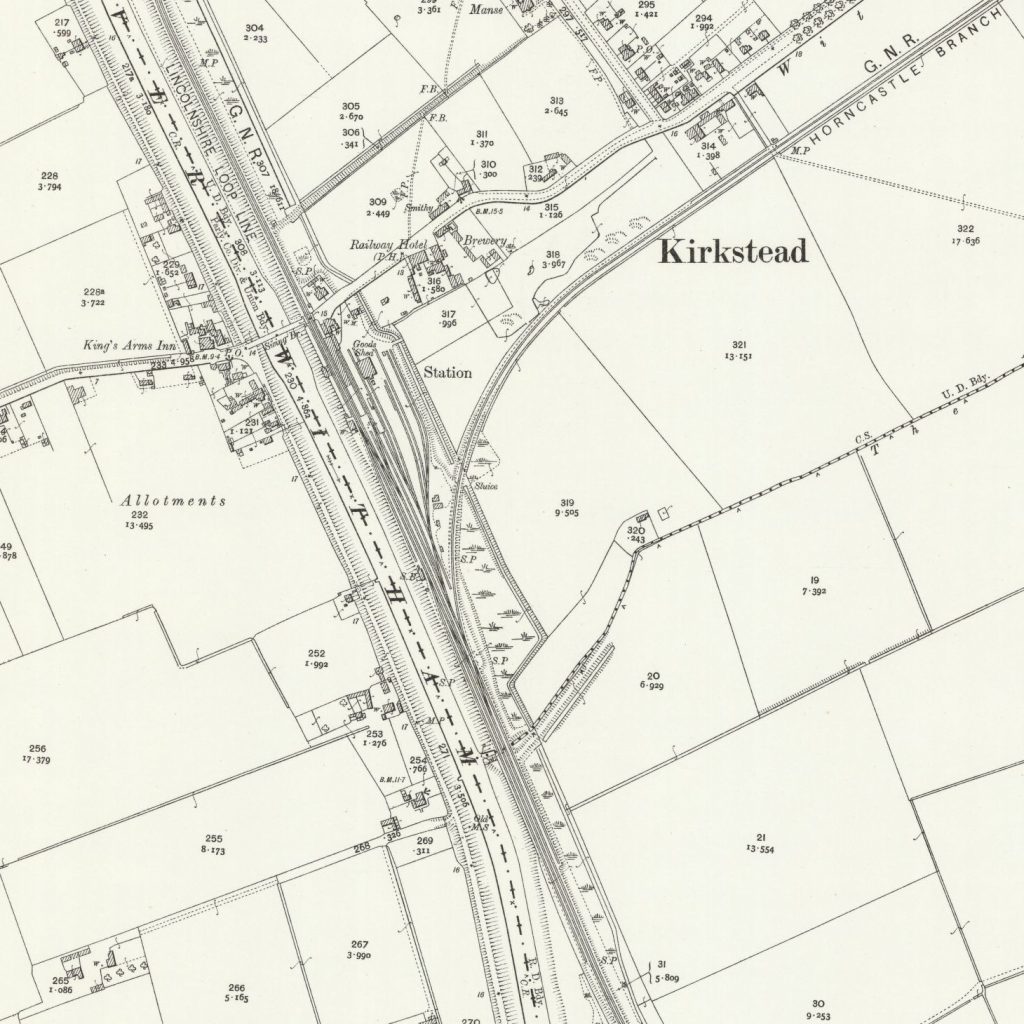
1905 25 inch-to-the-mile Ordnance Survey map of Woodhall Junction showing the two through platforms and the Horncastle bay platform with the yard to the East. The Horncastle Branch was accessed from the station and the yard via a reversal in the headshunt, although the trackwork did allow through running off the Branch onto the Up line. Just over a mile to the South of the station was Coningsby Junction, the point at which the 1913 'New Line' to Bellwater Junction diverged from the Boston line (the 'Lincolnshire Loop Line', as shown on the map). Copyright CC-BY (NLS) https://maps.nls.uk/

1956 1:10560 Ordnance Survey map of Horncastle showing the station with sidings on either side. The oil depot sidings were to the East (right hand side). The track laydown shown on this map is indicative, for example the platform line was in fact the through line from the branch and not accessed via a right-hand point by the signal box. Copyright CC-BY (NLS) https://maps.nls.uk/
Timetables
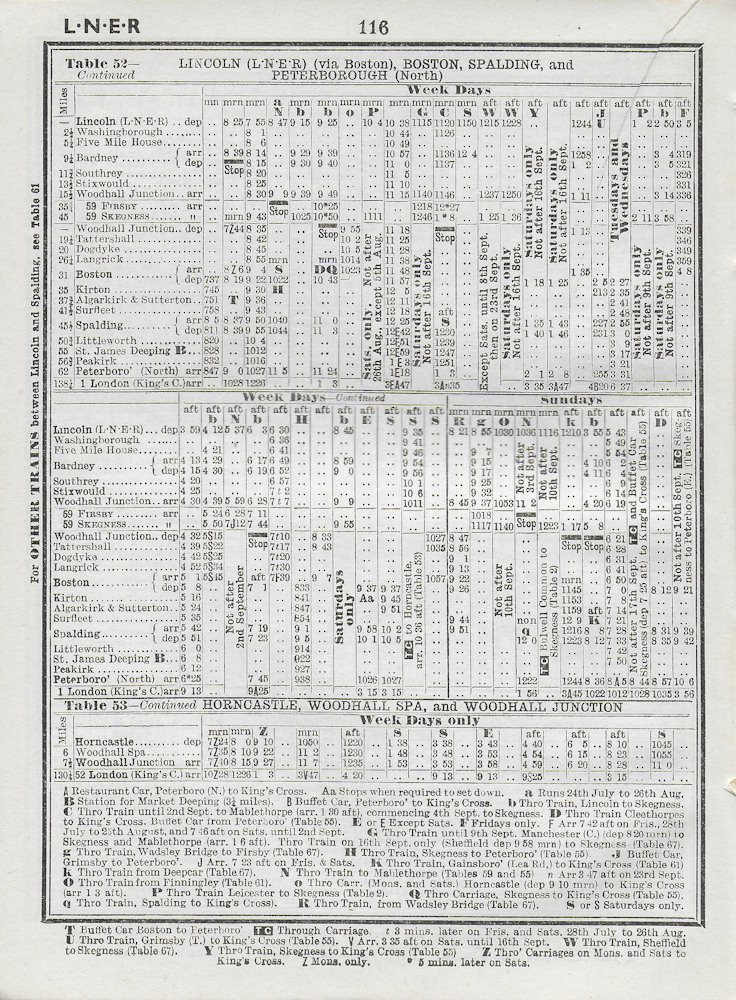
Extract from the Summer 1939 LNER Timetable covering the Horncastle Branch and the Loop Line via Woodhall Junction. On Mondays and Saturdays the 9.10 am from Horncastle conveyed through carriages to Kings Cross (arrival at 1.3 pm), with a 28 minute reversal at Woodhall Junction and a further 20 minutes at Boston where it joined the 9.5 am Cleethorpes to Kings Cross. Also joining at Boston was the 9.45 am from Skegness which ran non-stop to Boston via the Firsby Curve. Photo: Alan Jones.
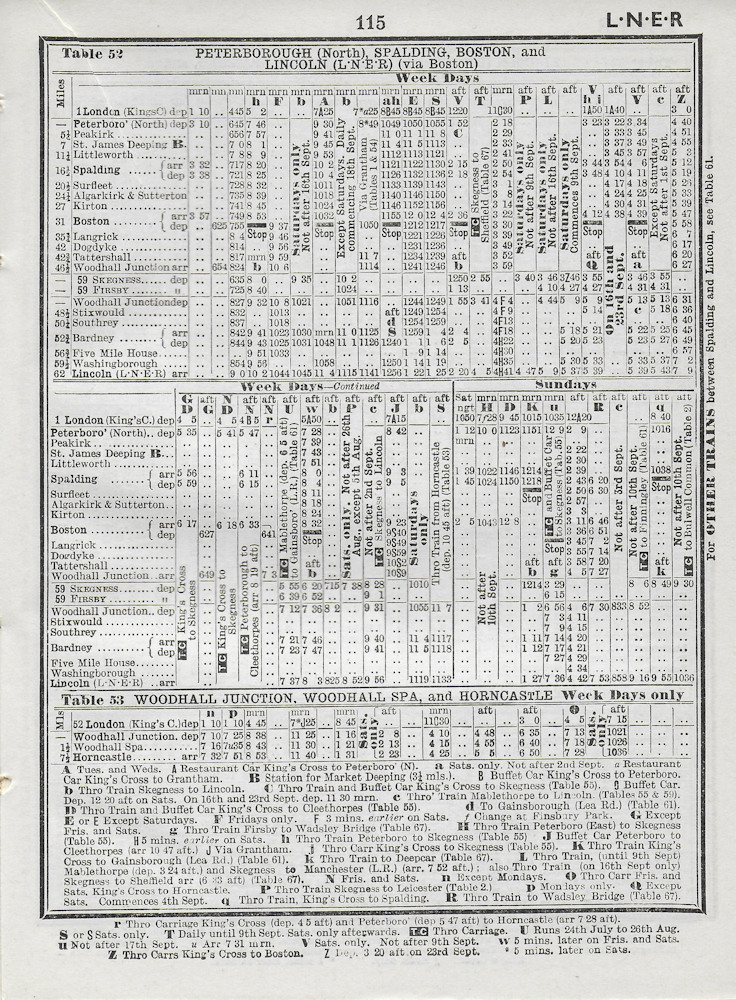
Summer 1939 LNER Timetable showing eight trains per day to Horncastle, with an additional two on Saturdays. Through carriages from Kings Cross were provided on Fridays and Saturdays, departing Kings Cross on the 4.5 pm to Cleethorpes and detached at Boston for a non-stop run to Woodhall Junction then a double reverse to access the Horncastle Branch, arriving at the terminus at 7.28 pm. Photo: Alan Jones.
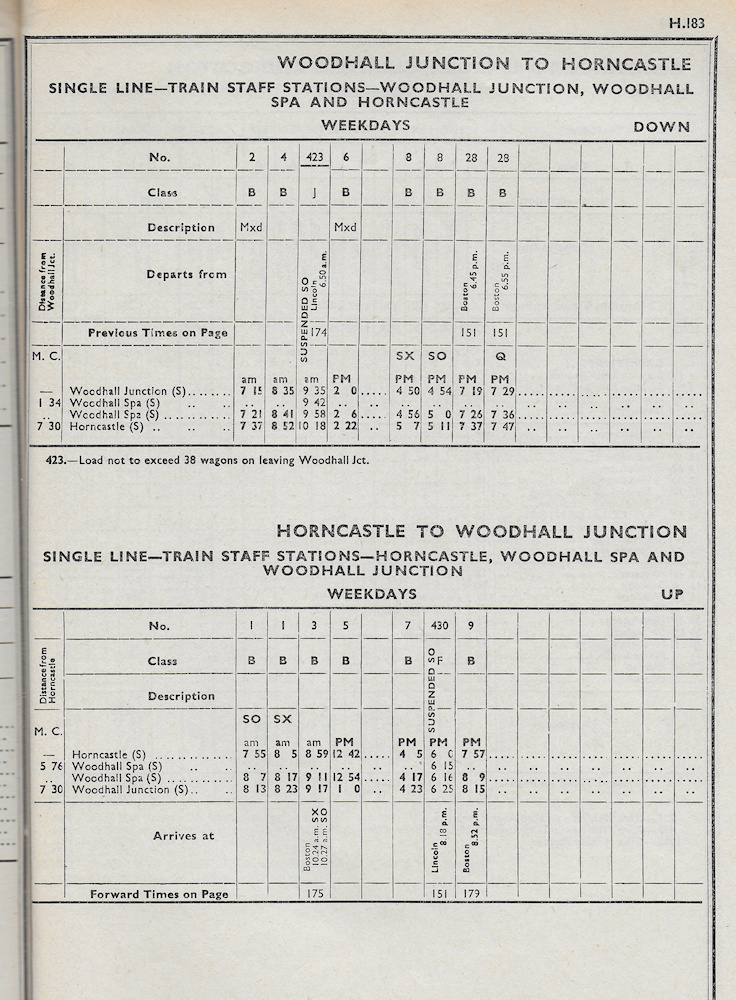
Summer 1953 BR Working Timetable for the Horncastle Branch. It is interesting to note the two mixed workings (Train Nos. 2 and 6) which are in addition to the daily trip working from Lincoln. Train No. 28 connected off the 4.0 pm Kings Cross to Cleethorpes at Boston. There is also an optional path for it to run 10 minutes later because a path existed for an additional 4.15 pm Kings Cross to Cleethorpes, as demand required, thereby allowing the Horncastle train to connect out of both Cleethorpes expresses. Photo: Alan Jones.

BR Eastern Region Summer 1953 Passenger Timetable for the Horncastle Branch, Up Line. Although the public timetable shows the last departure of the day from Horncastle at 7.57 pm running directly to Boston without calling at Woodhall Junction, the Working Timetable shows it running into the station at Woodhall Junction, arriving at 8.15 pm. Photo: Alan Jones.
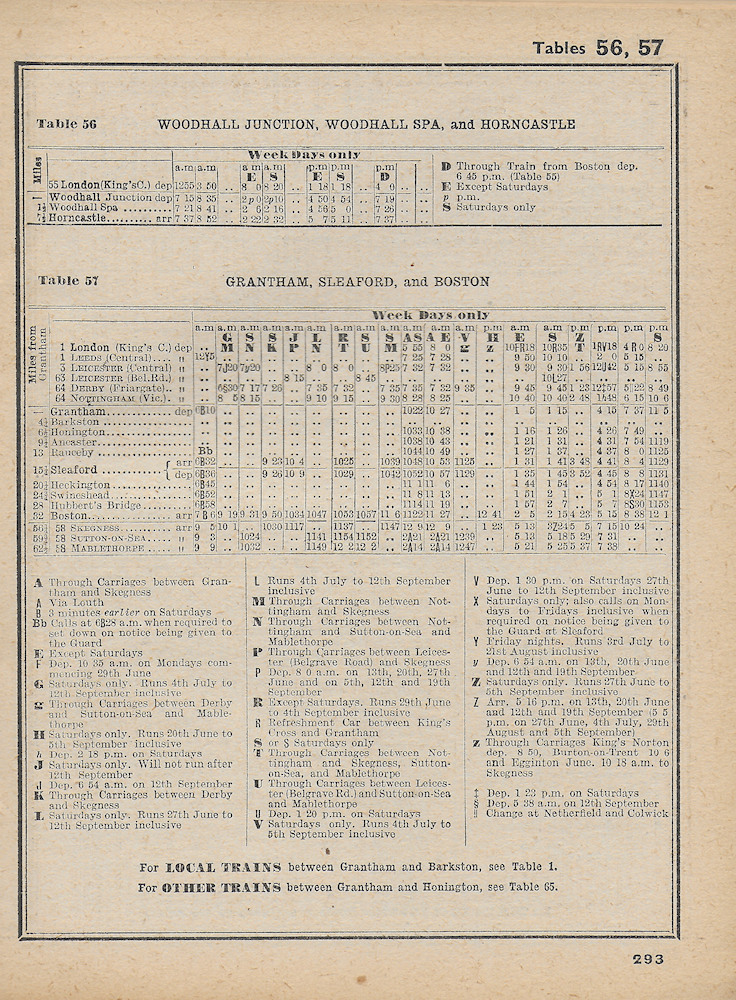
BR Eastern Region Summer 1953 Passenger Timetable for the Horncastle Branch, Down Line. The service is the regular pattern of five trains that connected out of services from Lincoln at Woodhall Junction. Note that the 7.29 pm departure from Woodhall Junction in the Working Timetable (Train 28, labelled as Q) does not feature in the public timetable. Presumably when this ran, passengers were left to believe they were ten minutes late. Photo: Alan Jones.
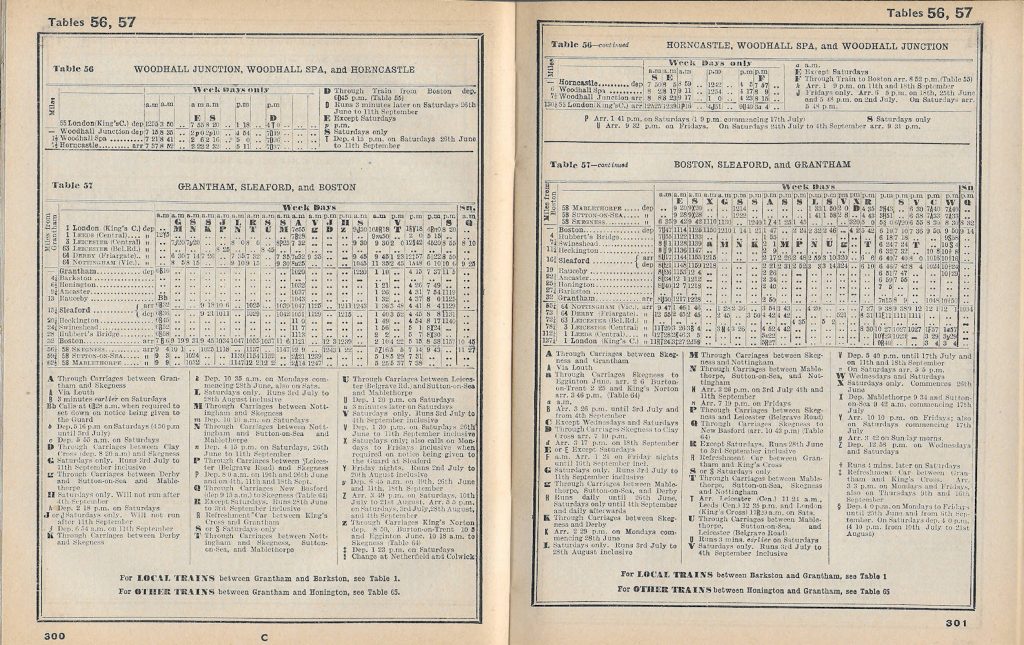
Saturday 11th September 1954 was the last day of passenger services on the Horncastle branch with the station officially closing to passengers on the following Monday. This is the Summer 1954 BR Eastern Region timetable - the last for the Branch. The service was its usual five trains per day with the final train of the day running through to Boston after reversal at Woodhall Junction. Photo: Alan Jones.

